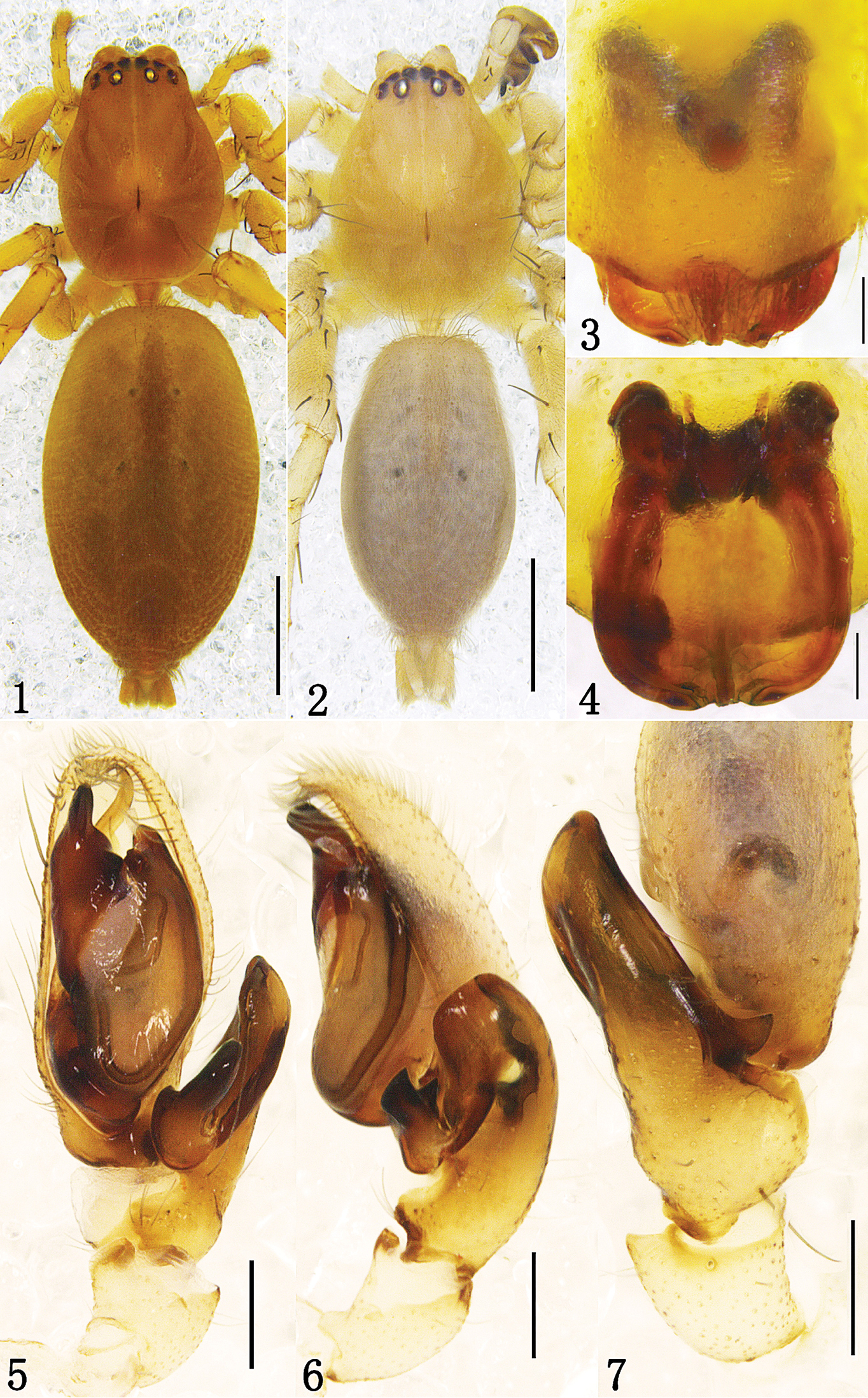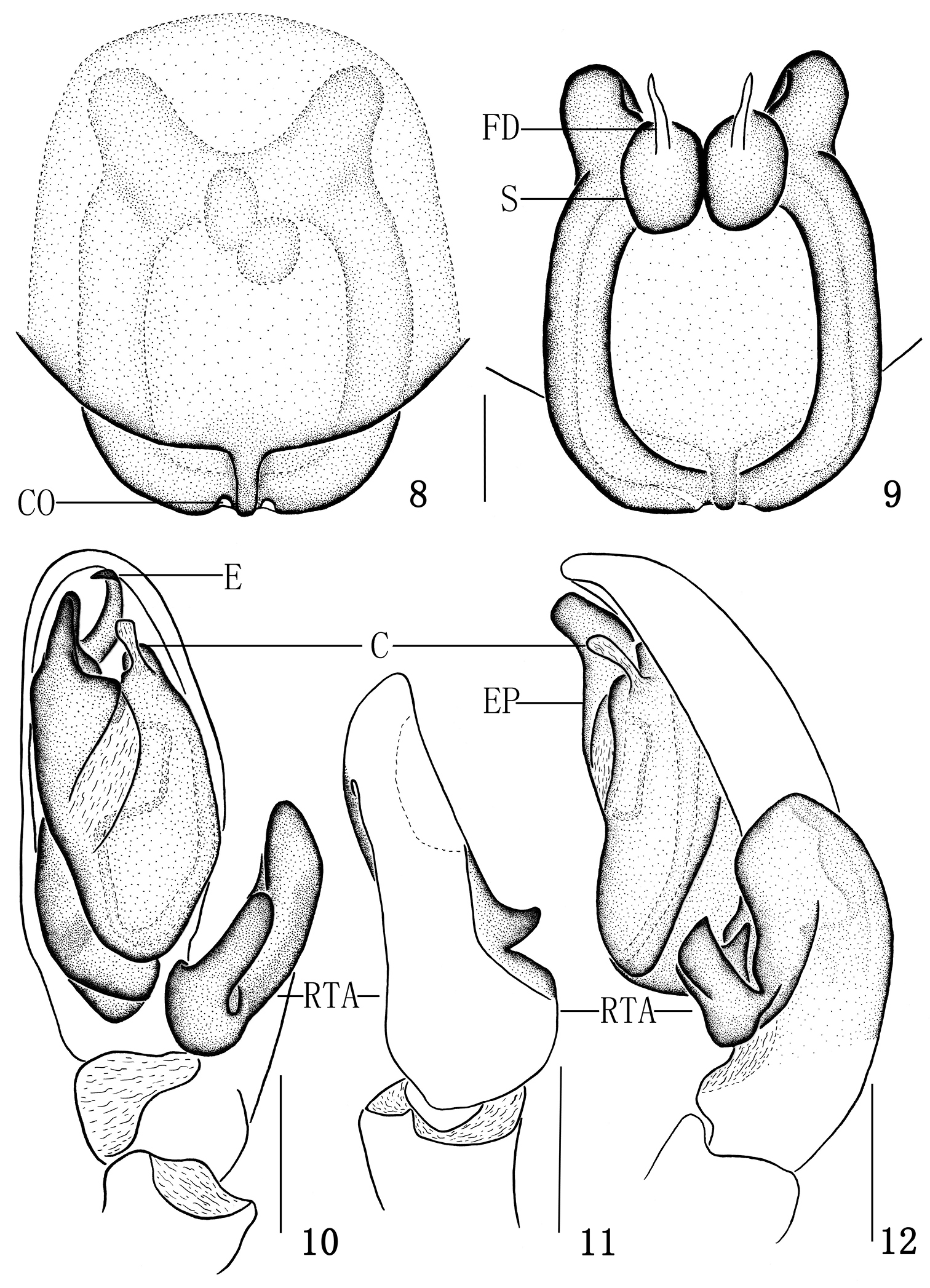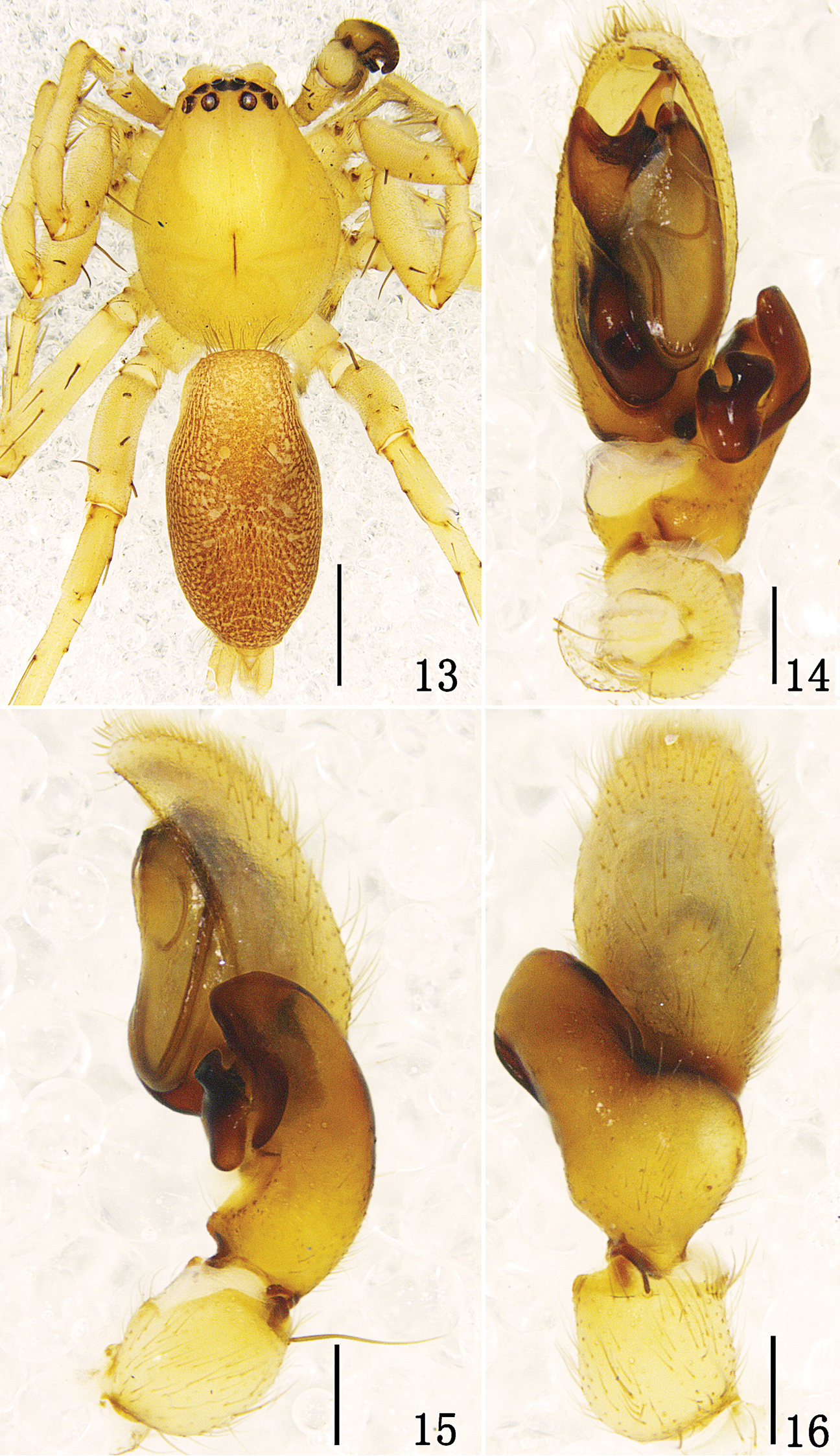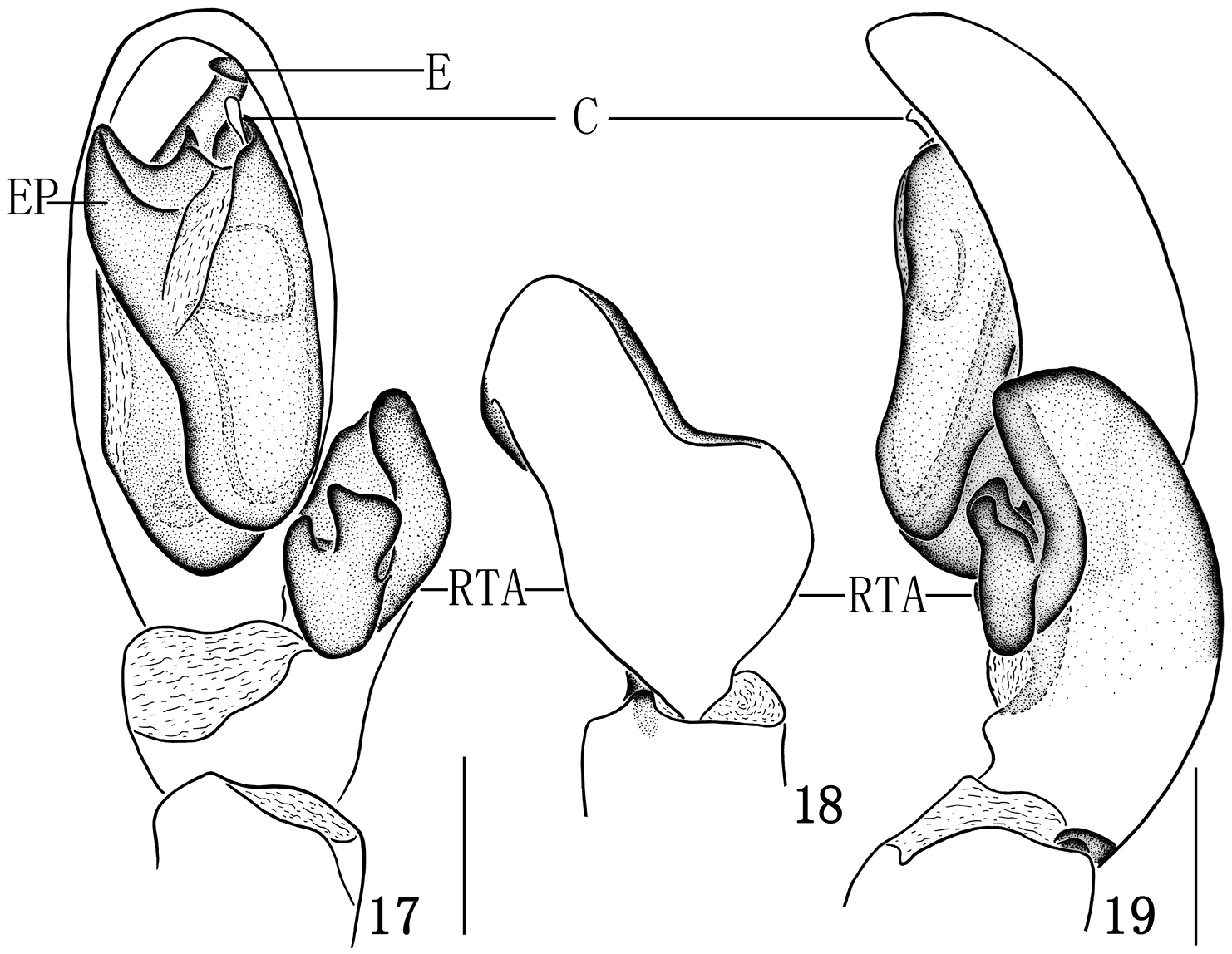






Citation: Wu P-L, Zhang F (2014) One new species of the Clubiona obesa-group from China, with the first description of Clubiona kropfi male (Araneae, Clubionidae). ZooKeys 420: 1–9. doi: 10.3897/zookeys.420.7770
The present paper describes two Clubiona obesa-group species: Clubiona bicuspidata sp. n. and the male Clubiona kropfi Zhang, Zhu & Song, 2003, which is described for the first time.
Spiders, taxonomy, Clubiona obesa-group
Clubiona Latreille, 1804, is the largest genus of the spider family Clubionidae. The genus encompasses approximately 465 species at present, is widely distributed around the world (except in South America) and has been revised both regionally and on a worldwide scale (
One of the largest species groups, Clubiona obesa, was first recognized by
All specimens were examined under a Tech XTL-II stereomicroscope. The drawings, photos and measurements were finished with a Leica M205A stereomicroscope equipped with a drawing tube and a DFC450 CCD camera. Carapace length was measured from the anterior margin to the posterior margin of the carapace medially. Eye sizes were measured as the maximum diameter of the lens in dorsal or frontal view. The measurements of legs are shown as total length (femur, patella, tibia, metatarsus, tarsus). The epigynum was cleared in a solution of potassium hydroxide (KOH) and transferred to 75% ethanol for drawing, taking photos and measuring. All measurements are in millimeters. All specimens studied are kept in 75% ethanol and deposited in the Museum of Hebei University (MHBU), Baoding, China.
The following abbreviations are used: ALE, anterior lateral eyes; AME, anterior median eyes; C, conductor; CO, copulatory openings; E, embolus; EP embolar part of bulbus; FD, fertilization ducts; MOA, median ocular area; PLE, posterior lateral eyes; PME, posterior median eyes; RTA, retrolateral tibial apophysis; S, spermathecae.
Holotype ♀, China, Hebei Province, Laiyuan County, Baishi Mountain (39°12'N, 114°42'E), 16 July 1999, Feng Zhang leg., deposited in MHBU, examined.
China: Hebei Province: Yu County, Xiaowutai Mountain (39°57'N, 114°48'E), 1 ♂ and 3 ♀, Shuigou Valley, 24 August 2012, Feng Zhang leg.; 1 ♂, Zhengjiagou Valley, 28 August 2012, Feng Zhang leg.; 1 ♂, Shuigou Valley, 5 July 2013, Panlong Wu leg.
This species was described on the basis of the holotype female with the male unknown.
This species is similar to Clubiona bakurovi (Mikhailov, 1990: f. 61–65), but can be distinguished by the hilt-like ventral branch of RTA, the tip of the embolus short and anti-clockwise, the EP wedge-shaped lacking a large tooth; the absence of epigynal grooves; the copulatory openings situated on the posterior edge of epigyne, and the septum thin.
Male. Total length 4.26–4.58. ♂ from Xiaowutai Mt: body 4.26 long; carapace 1.87 long, 1.31 wide; abdomen 2.24 long, 1.26 wide. Carapace yellowish. Head region slightly elevated above thorax. In dorsal view, anterior eye row slightly recurved, posterior eye row almost stright. Eye sizes and interdistances: AME 0.08, ALE 0.10, PME 0.08, PLE 0.10; AME–AME 0.04, AME–ALE 0.04, PME–PME 0.18, PME–PLE 0.12. MOA 0.27 long, front width 0.24, back width 0.35. Clypeus height 0.02. Chelicerae yellowish, promargin with six teeth, retromargin with three teeth. Endites yellow, longer than wide. Labium yellow brown, longer than wide. Abdomen oval, brown yellow, with conspicuous anterior tufts of hairs, dorsum with yellow thin hairs, cardiac pattern yellow brown; venter brown yellow. Spinnerets and legs yellow brown. Measurements of legs: leg I 4.60 (1.32, 0.65, 1.25, 0.86, 0.52), II 4.80 (1.40, 0.68, 1.33, 0.87, 0.52), III 4.23 (1.26, 0.56, 0.92, 1.02, 0.47), IV 6.17 (1.71, 0.67, 1.44, 1.77, 0.58). Male palp as in Figs 5–7, 10–12: RTA strongly expanded, forked, with hilt-like ventral branch; embolus arching behind tegulum and directing prolaterally; EP apophysis strong, wedge-shaped, with a triangular membrane proximally; conductor small, club-like, membranous.
Clubiona kropfi, 1 female habitus, dorsal view 2 male habitus, dorsal view 3 epigyne, ventral view 4 vulva 5 left male palp, ventral view 6 same, retrolateral view 7 same, dorsal view, showing tibial apophysis. Scale bars: 1 mm (1–2); 0.1 mm (3–4); 0.2 mm (5–7).
Clubiona kropfi, 8 epigyne, ventral view 9 vulva 10 left male palp, ventral view 11 tibial apophysis, dorsal view 12 left male palp, retrolateral view. Scale bars: 0.125 mm (8–9); 0.25 mm (10–12).
Female. Total length 4.73–4.98. ♀ from Xiaowutai Mt: body 4.98 long; carapace 1.82 long, 1.35 wide; abdomen 2.98 long, 1.79 wide. Eyes sizes and interdistances: AME 0.09, ALE 0.10, PME 0.08, PLE 0.10; AME–AME 0.05, AME–ALE 0.05, PME–PME 0.19, PME–PLE 0.13, ALE–PLE 0.07. MOA 0.28 long, front width 0.25, back width 0.41. Clypeus height 0.03. Labium 0.55 long, 0.24 wide. Endite 0.31 long, 0.24 wide. Measurements of legs: leg I 3.71 (1.10, 0.61, 0.90, 0.67, 0.43), II 3.90 (1.19, 0.63, 0.97, 0.68, 0.43), III 3.58 (1.09, 0.53, 0.72, 0.85, 0.39), IV 5.56 (1.60, 0.63, 1.24, 1.56, 0.53). Coloration darker than in male. Other characters as in male. Epigyne expanding posteriorly above epigastric groove, with a strongly sclerotized hind part. Copulatory openings separated from each other by a tongue-like process in the middle of the posterior part. Copulatory ducts directed laterad, then distad, almost parallel. Spermathecae spherical (Figs 3–4, 8–9).
China (Hebei).
Holotype ♂, China: Xizang Autonomous Region (29°12'N, 94°12'E), Mainling County, Mingsheng Zhu leg., 18 August 2002 (collected in subadult stage, matured 29 August 2002). Paratype: 1 ♂, China: Shaanxi Province, Zhouzhi County, Taibai Mt (33°57'N, 107°45'E), 25 May 2009, Zhisheng Zhang leg.
The new species resembles Clubiona baishishan (Zhang et al., 2003: f. 1A–F), but differs by the shorter embolus, two pointed distal EP apophyses, and the tip of RTA without a concavity in dorsal view.
The species name is an adjective, derived from the shape of EP apophyses.
Male. Total length 4.65–4.74. Holotype: body 4.65 long; carapace 2.21 long, 1.69 wide; abdomen 2.43 long, 1.26 wide. Carapace (Fig. 13) yellow. Cephalic region yellowish, slightly elevated above thorax. Median furrow longitudinal. Anterior eye row slightly recurved (in dorsal view), posterior eye row almost straight. AME black, and other eyes white. Eyes sizes and interdistances: AME 0.12, ALE 0.13, PME 0.14, PLE 0.11; AME–AME 0.07, AME–ALE 0.04, PME–PME 0.22, PME–PLE 0.12, ALE–PLE 0.07. MOA 0.31 long, front width 0.28, back width 0.45. Clypeal height 0.03. Chelicerae yellow, promargin with five teeth, retromargin with three teeth. Endites yellowish, serrula dark. Labium yellow brown, 0.51 long, 0.28 wide. Abdomen tan, with white speckles; cardiac mark yellow brown. Spinnerets and legs yellow. Measurements of legs: leg I 5.83 (2.03, 0.86, 1.18, 1.10, 0.66), II 6.48 (2.05, 0.78, 1.85, 1.15, 0.65), III 5.12 (1.54, 0.57, 1.29, 1.28, 0.44), IV 7.35 (2.15, 0.60, 1.65, 2.28, 0.67). Male palp as in Figs 14–19: RTA strongly expanded, forked, ventral branch with two processes, one incus-shaped and the other thumb-shaped. Embolus arching behind tegulum and directing prolaterally. Tegulum with two pointed EP apophyses, one small and one large. Conductor small, rod-like, membranous.
Clubiona bicuspidata sp. n. 13 male habitus, dorsal view 14 left male palp, ventral view 15 same, retrolateral view 16 same, dorsal view. Scale bars: 1 mm (13); 0.2 mm (14–16).
Clubiona bicuspidata sp. n. 17 left male palp, ventral view 18 tibial apophysis, dorsal view 19 left male palp, retrolateral view. Scale bars: 0.25 mm (17–19).
Female. Unknown.
China (Xizang, Shaanxi).
Thanks to Prof. Zhisheng Zhang (Southwest University, Chongqing, China) for providing valuable specimens. The English of the manuscript was kindly reviewed by Dr Jomo MacDermott. This work was supported by the National Natural Science Foundation of China (No. 31093430, 31372154), and in part by the Program of Ministry of Science and Technology of the Republic of China (2012FY110803) to Feng Zhang.



